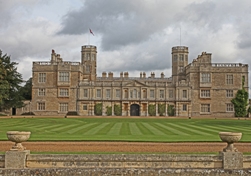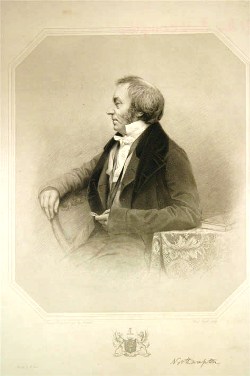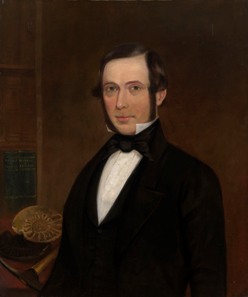 Anthony Brook takes the story of the geological Marquess on, with an account of his friendship with renowned palaeontologist, Gideon Mantell.
Anthony Brook takes the story of the geological Marquess on, with an account of his friendship with renowned palaeontologist, Gideon Mantell.
In the February 2014 issue of
Geoscientist Philip Compton reported (pp10-15) on the significant but neglected figure of Spencer Compton (1790-1851), who inherited the aristocratic title of 2nd Marquess of Northampton on the death of his father in May 1828. In his fascinating article he observes that Gideon Mantell was one of Spencer Compton’s oldest and closest friends, and provides extracts from two letters from Mantell to Lord Northampton in the Compton family archives (21 July, 1832 and 30 August, 1845).
I would like to add a little more substance to this remarkable friendship between Gideon Mantell and Spencer Compton, Marquess of Northampton. Although they came from very different strata of society (so critical in those days) they were almost contemporaries: they were born within a few months of eachother in 1790, and passed away within a year or so of eachother in 1851-52, so their adult lives spanned the same period of rapid developments in the exciting new science of Geology in the first half of the 19th Century.
Italian sojourn
 Spencer Compton (left) returned to England after a decade-long sojourn in Italy in November 1830 as a rich widower with a young family and as a peer of the realm, and resided thereafter at Castle Ashby (pictured above), in Northamptonshire. Mantell and Compton became acquainted during the course of 1831 through their joint enthusiasm for rocks and fossils. By that time Mantell had already made his name and reputation in geological circles, establishing his credentials with Fossils of the South Downs (1822) and, even more so, with his discovery of Iguanodon in 1825, which earned him the coveted designation FRS. and membership of the scientific and social elite, those social circles in which Lord Northampton moved with such consummate ease and political skill.
Spencer Compton (left) returned to England after a decade-long sojourn in Italy in November 1830 as a rich widower with a young family and as a peer of the realm, and resided thereafter at Castle Ashby (pictured above), in Northamptonshire. Mantell and Compton became acquainted during the course of 1831 through their joint enthusiasm for rocks and fossils. By that time Mantell had already made his name and reputation in geological circles, establishing his credentials with Fossils of the South Downs (1822) and, even more so, with his discovery of Iguanodon in 1825, which earned him the coveted designation FRS. and membership of the scientific and social elite, those social circles in which Lord Northampton moved with such consummate ease and political skill.
Lord Northampton paid a visit to Mantell’s Museum at Castle Place, Lewes on Monday 28 November 1831, as Mantell recorded in his journal: ‘Marquess of Northampton paid me a visit and spent 3 hours in the Museum. His Lordship was much pleased with his visit; he is a very agreeable and intelligent man’. Lord Northampton returned a week later, for a further visit, this time with his sister: ‘they stayed several hours’.
Castle Ashby
 Gideon Mantell (right) and Spencer Compton met, mingled and conversed at the British Association for the Advancement of Science Meeting in Oxford on 19-22 June 1832. A year later, from 29 June to 3 July 1833, Mantell paid an extended visit to Castle Ashby, in the company of other eminent geologists of the era, such as Murchison, and was suitably impressed by the grand house and extensive estate, even more so by His Lordship’s large collection of minerals and fossils. After Mantell moved to Brighton and established his Museum Lord Northampton paid an extended visit on 4-5 May 1835; a box of fossils from His Lordship from Italy arrived on 1 July.
Gideon Mantell (right) and Spencer Compton met, mingled and conversed at the British Association for the Advancement of Science Meeting in Oxford on 19-22 June 1832. A year later, from 29 June to 3 July 1833, Mantell paid an extended visit to Castle Ashby, in the company of other eminent geologists of the era, such as Murchison, and was suitably impressed by the grand house and extensive estate, even more so by His Lordship’s large collection of minerals and fossils. After Mantell moved to Brighton and established his Museum Lord Northampton paid an extended visit on 4-5 May 1835; a box of fossils from His Lordship from Italy arrived on 1 July.
The Marquess of Northampton was one of the four Trustees and Vice-Patrons of the Sussex Scientific and Literary Institution and Mantellian Museum, in the latter days of Mantell’s short time in Brighton; and helped to facilitate the forced sale of Mantell’s fossil collection to the British Museum. Indeed, he acted as one of the valuers in the summer of 1838, ensuring the best possible price.
1838 was the year when Mantell moved to London, first to Clapham Common and then, in 1841, to Chester Square. It was also the year that Lord Northampton was elected President of The Royal Society, serving in that prestigious office until 1848. During the 1840s Mantell attended many soirées and receptions given by his good friend and scientific colleague - such as the occasion in 1846 when he displayed a 3D model of the Isle of Wight and explained its strata and structure to the Society’s Patron, Prince Albert. Moreover, Mantell presented most of his more important scientific papers to Meetings of The Royal Society during the presidency of Lord Northampton, and they were subsequently published in The Philosophical Transactions.
On 29 March 1841 Mantell wrote to Benjamin Silliman, his transatlantic correspondent, that ‘microscopical investigations are now all the rage in every department of science’. Five years later, in April 1846, he published Thoughts on Animalicules: A Glimpse of the Invisible World revealed by the Microscope, and dedicated the volume to ‘The Marquess of Northampton, President of The Royal Society’.
Dinosaur
Mantell even named a dinosaur in honour of his old friend. He published an important paper ‘On the Structure of the Jaws and Teeth of the Iguanodon’ in Philosophical Transactions (V 138, 1848), which has the following Supplementary Remarks (pp 198-99): ‘I therefore propose to distinguish this fossil Saurian by a name indicative of the district from which, in common with so many relics of the same class where it was obtained, Regnosaurus, with the specific appellant northamptoni, as a tribute to the eminent nobleman whose approaching retirement from the Presidency of The Royal Society is so much to be regretted’. Regnosaurus northamptoni is still the provisionally-valid name for a ‘basal Stegosaur’.
Spencer Compton was found dead in bed on the morning of 17 January 1851 at Castle Ashby. Gideon Mantell wrote in his journal the next day: ‘Death of M. of N., at Castle Ashby, announced in The Times this morning, after a few day’s indisposition. The most estimable and kind scientific friend I have is thus taken suddenly from me: I am greatly shocked by this unexpected bereavement’.
Mantell and Northampton maintained a regular and continuous correspondence from the time of their acquaintance in 1831 until at least 1847, with 64 letters in the Mantell Correspondence Archive, on microfilm, at the East Sussex Records Office. Together with others in the Compton family archive at Castle Ashby, we have a remarkable repository of a sustained friendship, based on mutual respect arising from a common interest in geology, between an aristocratic patron of the arts and sciences, and a provincial pioneer geologist of humble origins. The common pursuit of geological matters, rocks and fossils, strata and structure, could overcome the inflexible barriers of class and society of the time.